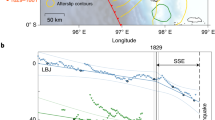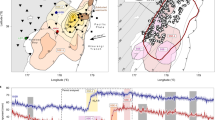Abstract
As oceanic lithosphere subducts beneath continental lithosphere it experiences variable degrees of interaction with the overriding plate and movement is accommodated by a continuum of slip modes1. At shallow depths, the plates are locked and movement occurs intermittently as earthquakes. By contrast, at large depths the down-going plate slips into the mantle continually. In the transition zone between locked and stable slip, plate movement is accommodated by slow slip2, which generates tectonic tremor3. Here we use tectonic tremor to infer the location and duration of slow slip in the Cascadia subduction zone from 2006 to 2011. We find that individual slow-slip events are initiated deep on the plate interface and migrate upwards. With decreasing depth, we observe a gradation from small, frequent slip, to large, infrequent slip. These observations fill in the transition zone with a continuum of slip size and periodicity, and indicate that the fault weakens with depth, which we attribute to lower friction. We suggest that stable sliding loads the fault at depth and transfers stress to the base of the transition zone, causing the initiation of slow slip. In a self-similar process, slow slip migrates upwards and ratchets stress up the fault, towards the shallower seismogenic zone. Our conceptual model provides an intuitive understanding of subduction zone dynamics.
This is a preview of subscription content, access via your institution
Access options
Subscribe to this journal
Receive 12 print issues and online access
$259.00 per year
only $21.58 per issue
Buy this article
- Purchase on Springer Link
- Instant access to full article PDF
Prices may be subject to local taxes which are calculated during checkout




Similar content being viewed by others
References
Peng, Z. & Gomberg, J. An integrated perspective of the continuum between earthquakes and slow-slip phenomena. Nature Geosci. 3, 599–607 (2010).
Dragert, H., Wang, K. & James, T. S. A silent slip event on the deeper Cascadia subduction interface. Science 292, 1525–1528 (2001).
Obara, K. Nonvolcanic deep tremor associated with subduction in southwest Japan. Science 296, 1679–1681 (2002).
Rogers, G. & Dragert, H. Episodic tremor and slip on the Cascadia subduction zone: The chatter of silent slip. Science 300, 1942–1943 (2003).
Wech, A. G., Creager, K. C. & Melbourne, T. I. Seismic and geodetic constraints on Cascadia slow slip. J. Geophys. Res. 114, B10316 (2009).
Miller, M. M., Melbourne, T., Johnson, D. J. & Sumner, W. Q. Periodic slow earthquakes from the Cascadia subduction zone. Science 295, 2423 (2002).
Dragert, H., Wang, K. & Rogers, G. Geodetic and seismic signatures of episodic tremor and slip in the northern Cascadia subduction zone. Earth Planets Space 56, 1143–1150 (2004).
Mazzotti, S. & Adams, J. Variability of near-term probability for the next great earthquake on the Cascadia subduction zone. Bull. Seismol. Soc. Am. 94, 1954–1959 (2004).
Shelly, D. R., Beroza, G. C. & Ide, S. Non-volcanic tremor and low-frequency earthquake swarms. Nature 446, 305–307 (2007).
Shelly, D. R., Beroza, G. C., Ide, S. & Nakamula, S. Low-frequency earthquakes in Shikoku, Japan, and their relationship to episodic tremor and slip. Nature 442, 188–191 (2006).
Wech, A. G. & Creager, K. C. Cascadia tremor polarization evidence for plate interface slip. Geophys. Res. Lett. 34, L22306 (2007).
Brown, J. R. et al. Deep low-frequency earthquakes in tremor localize to the plate interface in multiple subduction zones. Geophys. Res. Lett. 36, L19306 (2009).
La Rocca, M. et al. Cascadia tremor located near plate interface constrained by S minus P wave times. Science 323, 620–623 (2009).
Aguiar, A. C., Melbourne, T. I. & Scrivner, C. W. Moment release rate of Cascadia tremor constrained by GPS. J. Geophys. Res. 114, B00A05 (2009).
Ide, S., Beroza, G. C., Shelly, D. R. & Uchide, T. A scaling law for slow earthquakes. Nature 447, 76–79 (2007).
Wech, A. G. & Creager, K. C. Automated detection and location of Cascadia tremor. Geophys. Res. Lett. 35, L20302 (2008).
Obara, K., Tanaka, S., Maeda, T. & Matsuzawa, T. Depth-dependent activity of non-volcanic tremor in southwest Japan. Geophys. Res. Lett. 37, L13306 (2010).
Audet, P., Bostock, M. G., Boyarko, D. C., Brudzinski, M. R. & Allen, R. M. Slab morphology in the Cascadia fore arc and its relation to episodic tremor and slip. J. Geophys. Res. 115, B00A16 (2010).
McCrory, P. A., Blair, J. L., Oppenheimer, D. H. & Walter, S. R. Depth to the Juan de Fuca slab beneath the Cascadia subduction margin: A 3-D model for sorting earthquakes. US Geol. Surv. Dig. Data Ser. 91 (2004).
Linde, A. T. & Silver, P. G. Elevation changes and the great 1960 Chilean earthquake—support for aseismic slip. Geophys. Res. Lett. 16, 1305–1308 (1989).
Matsuzawa, T., Hirose, H., Shibazaki, B. & Obara, K. Modeling short- and long-term slow slip events in the seismic cycles of large subduction earthquakes. J. Geophys. Res. 115, B12301 (2010).
Liu, Y. J. & Rice, J. R. Slow slip predictions based on granite and gabbro friction data compared to GPS measurements in northern Cascadia. J. Geophys. Res. 114, B09407 (2009).
Audet, P., Bostock, M. G., Christensen, N. I. & Peacock, S. M. Seismic evidence for overpressured subducted oceanic crust and megathrust fault sealing. Nature 457, 76–78 (2009).
Blanpied, M. L., Lockner, D. A. & Byerlee, J. D. Frictional slip of granite at hydrothermal conditions. J. Geophys. Res. 100, 13045–13064 (1995).
Ide, S. Striations, duration, migration and tidal response in deep tremor. Nature 466, 356-U105 (2010).
Segall, P., Rubin, A. M., Bradley, A. M. & Rice, J. R. Dilatant strengthening as a mechanism for slow slip events. J. Geophys. Res. 115, B12305 (2010).
Nakata, R., Suda, N. & Tsuruoka, H. Non-volcanic tremor resulting from the combined effect of Earth tides and slow slip events. Nature Geosci. 1, 676–678 (2008).
Meade, B. J. & Loveless, J. P. Predicting the geodetic signature of M−W>=8 slow slip events. Geophys. Res. Lett. 36, L01306 (2009).
Wech, A. G., Creager, K. C., Houston, H. & Vidale, J. E. An earthquake-like magnitude-frequency distribution of slow slip in northern Cascadia. Geophys. Res. Lett. 37, L22310 (2010).
Brudzinski, M. R. et al. Non-volcanic tremor along the Oaxaca segment of the Middle America subduction zone. J. Geophys. Res. 115, B00A23 (2010).
Hirose, H. & Obara, K. Repeating short- and long-term slow slip events with deep tremor activity around the Bungo channel region, southwest Japan. Earth Planets Space 57, 961–972 (2005).
Acknowledgements
This work was funded by grants from the USGS G09AP00024, G10AP00033 and the National Science Foundation EAR-0545441.
Author information
Authors and Affiliations
Contributions
A.G.W. performed tremor detection and depth analysis. K.C.C. developed methods for cataloguing tremor into swarms. A.G.W. and K.C.C. collaboratively provided interpretation.
Corresponding author
Ethics declarations
Competing interests
The authors declare no competing financial interests.
Supplementary information
Supplementary Information
Supplementary Information (PDF 394 kb)
Rights and permissions
About this article
Cite this article
Wech, A., Creager, K. A continuum of stress, strength and slip in the Cascadia subduction zone. Nature Geosci 4, 624–628 (2011). https://doi.org/10.1038/ngeo1215
Received:
Accepted:
Published:
Issue Date:
DOI: https://doi.org/10.1038/ngeo1215
This article is cited by
-
Synchronous Tremor Modulation During the Passage of 2012 Super-typhoon Jelawat in Nankai Trough: By Chance or Real Consequence?
Journal of the Geological Society of India (2022)
-
Correlation of porosity variations and rheological transitions on the southern Cascadia megathrust
Nature Geoscience (2021)
-
Fault zone heterogeneities explain depth-dependent pattern and evolution of slow earthquakes in Cascadia
Nature Communications (2021)
-
Geological constraints on the mechanisms of slow earthquakes
Nature Reviews Earth & Environment (2021)
-
Two-Dimensional Probabilistic Cell Automaton Model for Broadband Slow Earthquakes
Pure and Applied Geophysics (2019)



